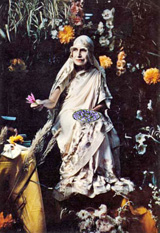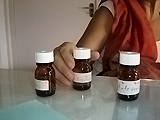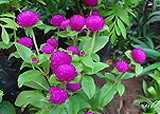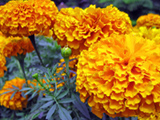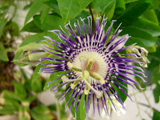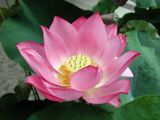Flower remedies with significances from the Mother (II)
Editor’s note
When the Mother was asked, “What is the way to get out of the obsession of pain when it is too much?” She answered, “Look at a beautiful flower”(1) Flowers restore us to health and harmony by their fragrance, their beauty and even their remedies as is seen in this article...
“Flowers teach us the charm of silence and thus the self-giving which demands nothing in return.”A flower remedy is not just a drug that acts to cure an illness. It opens the inner spaces and gives a feeling of wellbeing. As someone remarked after seeing a person who was taking these remedies, “What has happened? You have changed!” There is a new glow, a new feeling, a fresh outlook to life. Unknowingly, inexplicably one feels lighter and happier. There can be a sense of ease or of peace or of joy or just an élan which the people around sense.
As each remedy has a character of its own, the same remedy may or may not be useful for a person with similar psychological or physical traits.Also, the same person at different times of life may need different remedies though the traits of one particular remedy are stronger. Another interesting feature is that the physical illness only reflects the inner disequilibrium. If the physician can discover this inner disorder, the remedy works miraculously. Otherwise one can go on prescribing Integral Immortality for chest pain and arthritis or Divine Love for constipation and have no results.
For me, the whole concept of viewing illness changed as I started working on these remedies. For example, injury to the knee joint for young athletic people is a common problem. It can cause ligament disruptions, meniscus tears, chip fractures, etc. That these grossly physical problems could be helped by flower remedies was an eye opener.
These two young men had been in accidents. One had consecutively had three roadside accidents. In one he had become unconscious and had to be carried to the Nursing Home. He was a dreamy person who got carried away into other worlds while doing mechanical things like walking or eating. Since childhood he had been a dreamer. And now he was in severe pain. Ever since the accidents other things had healed but his knee had not. He could not walk without pain, could not sit in one position for long especially when the knee joint needed to be folded as in Japanese seat, could not run and jog. Even at night in sleep, if he turned in bed, or straightened the leg, the pain would be severe and excruciating, waking him from sleep. He had also taken homoeopathy for a year without much relief. An orthopaedic surgeon diagnosed it as a lateral meniscus tear.
As Integral Immortality with Plasticity had helped earlier for joint pains, I gave it to him. No effect.
Then it struck me, despite having had a serious accident on the road, he still could not focus on the material plane. He had had recurrent injuries which had forced him to connect to his body. Now due to the knee pain he had to constantly pay attention to it which was more disturbing to him than the pain itself. A very beautiful person, he had consecrated his life to the Divine – and now this knee pain. He was the shy leader, the ideal for others, the dedicated worker. He needed to harmonise the inner being to the physical realities.
I gave him Integral Harmony.
In 15 days he reported a remarkable change.
Almost 50 % of the pain had gone.
In one month, 80-90% of the pain had disappeared. He could walk long distances without pain, there was no pain while sleeping, he could sit and squat without pain, he could even sit in a Japanese seat. He only felt a slight stiffness off and on. The most interesting thing was that he was now aware of what was happening on the road and around him.
He had been reporting some bad dreams: dreams of missing the train, of being unsuccessful, etc.
As the complaints had almost gone and the rate of improvement very much slowed down, I gave him Life Energy. The results were dramatic again. He came back exuberant and walking fast. There was a strength and vibrancy in his movements. He said he had been having dreams he never had before. Dreams of courage, heroism and even if he saw a train there was no fear that he would miss it. Since things were improving psychologically, I felt we could continue Life Energy.
The result was devastating. He returned reporting that the knee pain had come back. Now he could not climb up and down the stairs without pain though he could walk. This pain had come back when he had enthusiastically started jogging which he had never done before. It was too much of Life Energy!
This person taught me a lot.
These remedies work deeply. They can bring balance and harmony and strength, but you must then know how you are going to use this. Also, the physician should be finely tuned to the changes in the person. The remedies should not be selected on one outer symptom or only one facet of the person. One should try to really look and feel into the inner imbalance that needs correction. Also one should allow the healing to happen at its own pace. ‘Trying to get quick results’ can have disastrous consequences. Not only the physical or mental changes are important, but also the other subtle nuances as a spontaneous quiet joy, a peace, a radiance...
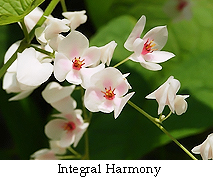 Just like some flowers blossom petal by petal,so slowly that one doesn’t even notice when and how they are fully in bloom – some remedies work gently and one must patiently await the blossoming of the person through months that follow. Other flowers like the passiflora and the lotus burst open in minutes before your eyes. The remedy too can work quickly, instantaneously opening something in the being (which has then to be maintained by personal effort also). This rhythm also is seen in people. There are people who react quickly and those that react gently and slowly and others who seem not to react but have been deeply affected.
Just like some flowers blossom petal by petal,so slowly that one doesn’t even notice when and how they are fully in bloom – some remedies work gently and one must patiently await the blossoming of the person through months that follow. Other flowers like the passiflora and the lotus burst open in minutes before your eyes. The remedy too can work quickly, instantaneously opening something in the being (which has then to be maintained by personal effort also). This rhythm also is seen in people. There are people who react quickly and those that react gently and slowly and others who seem not to react but have been deeply affected.
So the remedies differ and the rate of recovery differs.
Like this other young man of a strong vital temperament. All his brothers and his father and grandfather had been in the army. From a small village, where 75% of the males joined the armed forces, he was very strong but very short. So to his great disappointment he was rejected from military service and had joined the Ashram. Even before his birth he had been sustaining injuries. He had been born prematurely when his mother fell from a height while working in the fields. He had had several head and spinal injuries as a child by doing things like falling from the roof. He had a very strong willpower and used to have a photographic memory. But, according to him, after having eaten a huge amount of neem leaves as a challenge, he had lost his hair, his memory and also the ability to perspire. Off and on, he would get attacks of giddiness in which if he didn’t take care, he would fall unconscious and seriously injure himself. This had not been accompanied with frothing at the mouth or convulsions. He was a very good sportsman and worker. He was also a very good teacher and had taught many young and not so young people how to cycle. He had a deeply caring attitude for people who were not well and a capacity to heal. But now he was very disturbed. He had injured his knee when a jeep had knocked into it while he was sitting on a moped. At that moment he had bravely stepped down, readjusted his bleeding knee and gone to the Nursing Home. But even after 9 months the knee was acutely painful. He could not stand for long, could not run, could not do sports and would wake up in sleep with a start.
Even though many people admired him, he thought himself as having been rejected – rejected by his society and his body. He was out of harmony with himself. A very caring person, he got very angry if things were not right. After Integral Harmony very slowly, gently, things are changing.
The first action of the remedy was on a physical level. The perspiration started again. The heat subsided. The pain went down by almost 60%. His memory has improved. He has given up the idea of going for surgery for the knee.
The inner changes are very subtle. There is a quietness rather than rushing about. The rest is not spoken about... a feeling of wellbeing is settling.
If we consider things from a yogic perspective, all problems of existence are problems of harmony. Yet we cannot be prescribing Integral Harmony to all people. So what was common in the two people?
The picture that emerged following the work with Tarot2 was explicit.
“This remedy pushes you to find your way on earth, accept your solitude and find the harmony within yourself. It is useful for recurrent problems or in cases where environmental influences put you into imbalance. This remedy in a silent, gentle, motherly way, helps you to overcome the disturbance.
The dreams speak of your difficulty in acting and the feeling that others are taking advantage of you. In real life you are the one who looks after others. This remedy makes you accept the difficulties in your life which you have hitherto been unconcerned about. So you accept being on earth for some purpose. A great change ensues.”
The Mother says of Integral Harmony:
“Harmony between things, harmony between persons, harmony of circumstances and above all, harmony of all aspirations directed towards the Supreme Truth (1).”
This is the path towards which one using Integral Harmony can move to find wholeness and richness in the being.
Integral Harmony grows on a creeper that is botanically known as Antigonon Album, the coral vine, with white coloured flowers (2). The flowers look like small lanterns with a pink centre. It grows over other plants without disturbing them, bringing beauty and brightness. Periodically every year, the whole plant dies to spring up from the roots again in April.
1.Ed. Vijay. Flowers – their spiritual significance. Pondicherry; Sri Aurobindo Society, 1988, p. 74.
2. Changing/Turning wrong movements to right (Nerium Oleander, Magenta coloured (3))Brief description
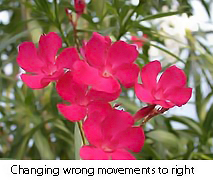 This is the single magenta or deep red coloured flowering oleander.
The plant is a large evergreen shrub with a milky latex. The leaves are dark green, pointed and three in a whorl. It is considered to be an ornamental plant and unlike other oleanders does not have a strong smell. The flowers are bright and immediately attract attention. They are reported to have the property of purifying the air (4).
This is the single magenta or deep red coloured flowering oleander.
The plant is a large evergreen shrub with a milky latex. The leaves are dark green, pointed and three in a whorl. It is considered to be an ornamental plant and unlike other oleanders does not have a strong smell. The flowers are bright and immediately attract attention. They are reported to have the property of purifying the air (4).Case study
This was a young, beautiful, fair, dynamic lady with severe stomach pain. She was the second daughter of a well-to-do family and always had to be better than the first. She was doing her thesis on a very difficult subject in which she had to go to places where no lady of social standing should go. She interacted with drug addicts and psychiatric patients. In the past few years, she had started becoming increasingly irritable and had developed a chronic amoebiasis. This time she did not want to take anti-amoebic treatment. So in a flash of inspiration she was given 'Turning wrong movements to right'.The pain dramatically subsided. The loose motions stopped. She was full of her usual energy and the glow on her face returned.
Another young boy revealed something more. He was an idealistic young man, appearing correct and deeply dissatisfied with himself. He suffered from mood swings, chest pain, and skin problems. He always felt a secret sense of guilt that he could not be what he aspired for. Yet what exactly was wrong he also could not perceive. He was one of the few people who wanted only flower remedies for any ailment. Brought up in a joint family with many brothers, he never got the attention of his parents. Nobody took trouble to make him study. He was left free to roam in the neighbourhood. So, as an adult, he always felt like improving his mind. As he had never really concentrated on studies, he could not adequately express himself. His memory and willpower were weak. At times his sleep was also disturbed. Whenever he took Turning wrong movements to right, he felt a deep relief. A smile returned and with it the enthusiasm.
In both these people the effects were very quick but did not last long. This was made clear in the study with Tarot.
“The remedy opens the mind to a vastness. Yet, on stopping it, the subconscient problems surface which have to be tackled. Physical and emotional tensions are released. The question these people ask themselves is ‘I want to be loved, I should be loved because I am the best, but why don’t people choose me?’ This question may never be put up verbally but lingers in their behaviour and actions.
“They cannot see the incorrectness of their behaviour (love does not come by being the best!) and feel guilty deep inside themselves. This remedy spontaneously helps them to detach for a moment and thus resolve conflicts. For inside them they have a deep honesty and a desire to change.
“The remedy shakes habits, routines and narrow ways of looking at things. There is a readjustment and balance. One can leave the egoistic way and open.”
As the Mother says about this flower,
“An extreme goodwill always ready to be transformed (5).”
2. Tarot is a game of symbolic cards devised by occidental esoterics for understanding man, the `Sacred Stone' hidden within, God and the universe.
3. Generosity
(Impatiens balsamina (6))
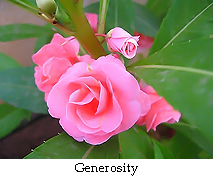
Brief description
The remedy
Can a flower remedy act on such a grossly physical disorder like habitual constipation?Generosity can. Of course if the person needs it. The profile of people who would be helped by Generosity is:
“They are concerned by the material level its structure and organisation. Physically quite strong and stable they are easily upset by a small skin problem, a little constipation, etc. They want to be looked after as they always missed this care as children. Mentally they focus on disorders in the past, sibling rivalries, acrimony, jealousy, etc. The remedy gently brings them back into balance. Like with other remedies, old scars, family patterns and recurrent disorders are then released. They are born again to their true nature – generous and healthy.”
This young girl, tempestuous and volatile, had come far from home in a small town for her surgery. She settled down in this place and made it her home. This was totally unusual even for men in her village. But she wanted her space, her place.
Ever since she remembers, her mother had never been mentally well. She did not connect to her children, who were then brought up by others. But this girl unlikethe other siblings was determined to rise. She was well-built, strong, intelligent and the one who told others what to do in practical difficulties. At a marriageable age, she was scarred during an accident. She retreated from the village and came to this new town where she did not know the people or the language and learnt both. Everybody admired her courage and strength. But she was extremely touchy. Slight comments could easily give rise to severe headaches and be considered as grave insults to be brooded over for days. She could create a fuss over a small scratch. She felt inferior to others and suffered deeply. As a family inheritance she had got anger, fixed ideas and constipation.
After one dose of Generosity she reported a marked change. She had, after months, passed a large amount of free clear stools. She felt relieved and happy. Over the months that followed, we saw her calm down, become generous and self-giving, happy, not hysterical over small hurts and contented. The confidence she has in herself is more genuine. She radiates a quiet ease.
As the Mother says of Generosity:
“Giving and self-giving without bargain(7).”
It is interesting to know that Yunani medicine considers this flower to be cooling and tonic. It is useful when applied to burns and scalds. It is typically used for joint pains. When taken internally it acts as an emetic, cathartic and diuretic(8).
4. Patience
(Mimusops elengi, Bakul (9))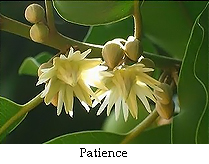
Brief description
These are flowers from a large evergreen tree, 12-15m high. The trunk is short and erect, the bark smooth and scaly. There is a deep cool shade under this tree. When it flowers, an intoxicating fragrance spreads around. These flowers have been the inspiration for many earstuds and are loved by all Indian women. They are small, circular, creamish brown and though appearing delicate, are very strong. The fragrance persists long, long after the flower has dried.The Mother says of Patience:
“Patience is our first great necessary lesson, but not the dull slowness to move of the timid, the sceptical, the weary, the slothful, the unambitious or the weakling; a patience full of a calm and gathering strength which watches and prepares itself for the hour of swift great strokes, few but enough to change destiny(10).”
The remedy of Patience also has a quick, strong action that lasts.
This was very evident when in a single dose it cleared off the sleep disorder in a girl who needed it.
There was a twenty-three year old simple, strong, quiet girl from a rural area, who had turned to the Mother and was managing a centre almost single-handedly. Though quiet in speech and temper, she would forcefully have her say when required. She sang and painted for the Divine. She left an impact on all who met her.
She looked like the flower Patience. Creamy white in complexion, soft but strong. Yet there was something inaccessible about her. She would bring succour to all around but one felt one could not really help her. She had come to Pondicherry, her heaven, but could not get sleep.
The result of Patience was astonishing. She not only never had sleep difficulties but became cheerful, talkative and communicative. It was like the bud had blossomed at a stroke!
In the work with Tarot, we later found,
“It brings clarity, transparency and a deep meaning to life. You develop the confidence that the Divine is looking after you. You realise the futility of action. This does not mean that you will not act but that you must choose the right way to act. One needing this remedy is a gentle quiet person looking for the meaning of his/her life.”
As the Mother says, it is:
“Indispensable for all action(11).”
According to Ayurveda, the flower is sweet, acrid, oleaginous, cooling and astringent. It cures diseases of the blood. A snuff made from the dried and powdered flowers is given in a disease called ahwah, common in Bengal. The symptoms of this disease are: strong fever, headache, pain in the neck, shoulders and other parts of the body. The powdered flowers induce copious discharge from the nose and relieve pain in the head.
A water distilled from the flowers is used as a perfume and stimulant in south India.
The flowers are also expectorant, cure liver complaints, diseases of the nose and headache. Their smoke is good for asthma (12).
Conclusion
This work is only one facet of these flower remedies. They could have other perspectives too, which would perhaps be revealed later and exposed through other people.So the work continues...
References
1. The Mother. Flowers and their messages. Pondicherry; Sri Aurobindo Ashram Trust, 1992, p. 17.2. Ibid., p. 17.
3. Ibid., p. 174.
4. Warrier, P. K., Nambiar, V. P. K., Ramankutty, C. Indian Medicinal Plants, Vol.4. Kottakals; Arya Vaidyasala; Orient Longman, p. 126.
5. Op Cit. Flowers and their messages. p. 174.
6. Ibid., p. 136.
7. Ibid., p. 136.
8. Kirtikar, K.R. and Basu, B.D. Indian Medicinal Plants, Vol.I. Dehradun; International Book Distributors, 1987, p. 446.
9. Op Cit. Flowers and their messages. p. 165.
10. Ibid., p. 165.
11. Ibid., p. 165.
12. Op Cit.Indian Medicinal Plants, Vol. II. p. 1495.
Dr. Vandana is working in the Sri Aurobindo International Institute for Integral Health and Research (SAIIIHR) on different aspects of health and illness.
Share with us (Comments, contributions, opinions)
When reproducing this feature, please credit NAMAH, and give the byline. Please send us cuttings.
